Evaluating Voluntary Stormwater Management Initiatives in Urban Residential Areas:
Making Recommendations for Program Development in the City of Vancouver
By Yota Hatziantoniou
yotah@interchange.ubc.ca
B.Sc., The University of British Columbia, 1999
A Thesis Submitted In Partial Fulfillment Of The
Requirements For The Degree Of
Master Of Science
In
The Faculty Of Graduate Studies
School of Community and Regional Planning
January 2002
The "Abstact", "Chapter 1" and "Conclusion" are included on this HTML page. The full thesis is 40,000 words long. To save space in the PDF, we have placed some of the images referred to in the thesis on this page as small files.
The complete thesis is available as a PDF (360K) here.
Abstract
As riparian and aquatic areas experience continued degradation from the pressures of human development, there is an increasing realization by watershed managers that measures must be taken to restore the urban hydrological cycle. Voluntary stormwater management and water conservation practices, such as those advocated by the Engineering Services Department (ESD) in Vancouver, British Columbia, provided an opportunity for homeowners to participate in the management of their water resources. Unfortunately, due to a number of unknown factors, the stormwater pilots in this city failed to receive the widespread adoption that was required for their subsequent expansion.
To inform the design of an integrated water management program that is capable of attracting a sufficient number of participants, a program evaluation framework was developed to assess the Downspout Disconnection Pilot Project, the Perforated Sump Pilot Project and the Rain Barrel Program in Vancouver, as well as the more popular Downspout Disconnection Program in Toronto, Ontario. Interviews of government staff and program participants, as well as reviews of theoretical and program literature, were used to understand the program variables that may have contributed to the different rates of program uptake observed in each city.
The results of the evaluations have been used to inform the design and implementation of future stormwater management initiatives in urban residential areas, as well as to recommend specific areas of program improvement for the City of Vancouver. The specific areas of program improvement identified include: i) dedication of adequate program resources, ii) implementation of complementary policies, iii) exploitation of opportunities for interdepartmental collaboration, iv) innovative program promotion, v) facilitation of homeowner participation, and finally, vi) monitoring of program performance over time and adoption of change. Through the design and implementation of an integrated water management program, the City of Vancouver would be able to demonstrate a commitment to innovative problem mitigation and environmental leadership, while helping to limit the impacts of urban (residential) runoff on the quality of its receiving waters.
Chapter 1: Introduction
1.1 Sustainability and Stormwater
Urban areas are located within the circulating cycles of water, carbon, oxygen, nitrogen and minerals. For these cycles to continue functioning, they must not be overly stressed. Individual and household decision-makers play a vital role in adopting changes that would lead towards the creation of more sustainable urban environments. Ecological sustainability refers to the ability of humans to i) maintain life support systems, ii) protect bio-diversity, and iii) use resources efficiently (Robinson and van Bers, 1996). Maintaining life-support systems refers to minimizing stresses on systems upon which humans and other living organisms rely for their well-being, which in the context of stormwater management, refers to components of the hydrological cycle, including soils, water and vegetation. Protecting bio-diversity refers to minimizing the loss of organisms - both those which are relied upon for sustenance, recreational or aesthetic purposes (e.g. salmonids) and those to which little human value is attributed, or about which there is little knowledge (e.g. soil microorganisms). Finally, using resources efficiently, in this context, refers to finding multiple uses for even those resources that have been traditionally thought of as highly disposable, or, of limited value.
The conversion of roof runoff into wastewater by virtue of its entry into the sewer system means not taking advantage of this resource for irrigation purposes, or ultimately, for reducing the consumption of potable water. In fact, reducing the consumption of resources in general is necessary for solving many local (and global) environmental problems (Johnson, 1995). Decisions made by people about how to carry out daily activities, or even decisions that are made for them but which they have power to influence, can affect the three components of ecological sustainability outlined above.
Ecological sustainability presumes that development can be brought into harmony with nature's limits of tolerance, by employing technological innovations, applying appropriate public policies and regulations, and by altering community and individual behaviours (Perks, 1995). According to Canada's Green Plan, environmental quality recovery is a duty that must be shared by all segments of society, and levels of government (Johnson, 1995). However, sustainable practices should be emphasized in urban areas, because this is where the majority of development takes place and where most environmental problems originate (Perks, 1995).
In recent decades, stormwater runoff has emerged as an issue of major concern to water resource managers (MELP, 1999). Stormwater affects local waterways both in terms of the volume of runoff that is generated, and the nature of the pollutants that may be conveyed (NRC, 1993). Allowing stormwater to infiltrate in urban residential areas is one way of managing runoff at-source, and by doing so, preventing a wide variety of down-stream effects.
In the City of Vancouver, the management of stormwater has been identified as one approach for minimizing the effects of impervious surface coverage and maximizing the conveyance and treatment capability of the combined stormwater/sanitary sewage system. Stormwater management practices (SMPs), and in particular, measures that promote the infiltration of rainwater into soils, can be used to decrease the imperviousness of urban residential areas, and to help restore the hydrological cycle in urban areas.
1.2 Thesis Goals and Specific Objectives
The first goal of this thesis is to evaluate the voluntary stormwater management and associated water conservation initiatives that have been introduced in Vancouver, British Columbia and Toronto, Ontario. The second goal of the thesis is to recommend stormwater management strategies for urban residential areas that could be applied to the specific case of Vancouver, British Columbia. The sub-objectives that lead to the achievement of these goals are:
- To explore the need for stormwater management and/or water conservation practices
in urban residential areas, as exemplified by Vancouver;
- To explore how stormwater initiatives in the City of Vancouver, if widely adopted,
could contribute to the water quality improvement goals of regional, provincial and
federal agencies.
- To develop an evaluative framework based on the principles of summative/formative
program evaluation, policy instrument evaluation, and community-based social
marketing;
- To develop performance measures and interview questions based on the criteria
identified in the evaluative framework;
- To obtain interview responses from Vancouver and Toronto program administrators
regarding their experiences with the design and implementation of the various
programs;
- To obtain interview responses from homeowners/program participants regarding their
experience with a stormwater or water conservation program;
- To assess the voluntary stormwater (and water conservation) programs in the Cities of
Toronto and Vancouver based on program documents and interview responses;
- To identify program weaknesses that need to be overcome and strengths that need to be further developed in any future initiative that integrates more than one aspect of water management;
Chapter 8: Conclusion
The management of stormwater runoff need not occur in isolation of other urban environmental initiatives. By pulling together the resources and expertise of more than one department in the City of Vancouver, it may be possible to create a program package that meets both homeowner concerns for flood protection, and city concerns for sewer performance and water quality. In addition, by integrating the management of stormwater with the conservation of potable water and the protection of homes from basement flooding, it may be possible to widen the range of benefits received by the target population, and at the same time, increase the program's ability to impact the problem setting.
A program evaluation framework has been used to take into account the inputs, process and outputs that characterize the stormwater/water conservation programs in each of the Cities of Vancouver and Toronto. The incorporation of policy instrument evaluation and community-based social marketing theory into this framework has helped to further inform and elaborate upon each program component, and to reveal a wide range of program 'strengths' and 'weaknesses'.
Through the evaluations made, six areas of program 'improvement' have also been identified to help eliminate any barriers associated with the design of a future integrated program, and to facilitate the creation of an institutional setting in which effective program delivery can be accomplished. These six areas of program improvement are: i) dedication of adequate program resources, ii) implementation of complementary policies, iii) exploitation of opportunities for interdepartmental collaboration, iv) innovative program promotion, v) facilitation of homeowner participation, and finally, vi) monitoring of program performance over time and adoption of change. The outcomes that could be expected as a result of these improvements include: reduced pressures on Vancouver's combined sewer system and drinking water supplies, fewer occurrences of basement flooding and combined sewer overflows, and increased homeowner awareness for the urban hydrological cycle.
Through the design and implementation of an integrated water management program, the City of Vancouver would be able to demonstrate a commitment to innovative problem mitigation and environmental leadership, while helping to limit the impacts of urban (residential) runoff on the quality of its receiving waters.
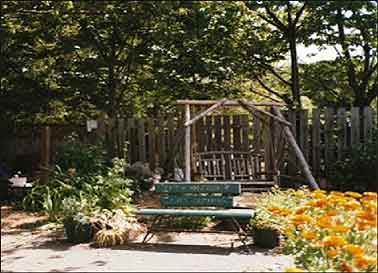
City Farmer's Demonstration Garden

Figure 1: City of Vancouver Combined Sewer Outfall Locations
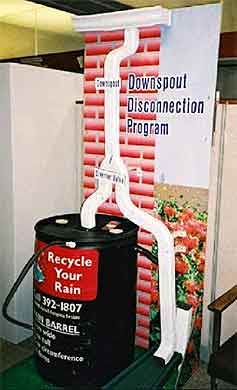
Toronto's Downspout Disconnection Program

Figure 5: Downspout Disconnection Program Pamphlet

Figure 6: Pamphlet Response Card
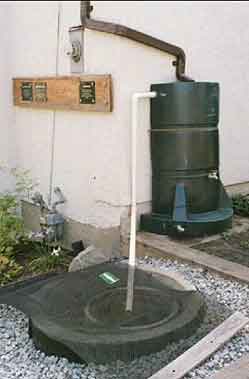
Vancouver Rain Barrel and Perforated Sump
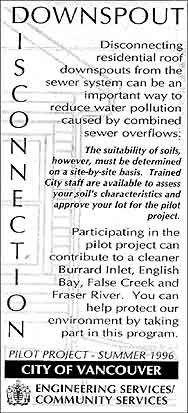
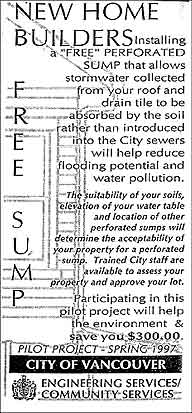
Figure 7: Sewers Design Branch Stormwater Pilot Pamphlets

![[new]](new01.gif)
